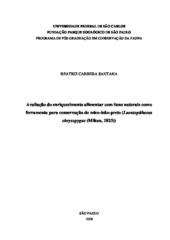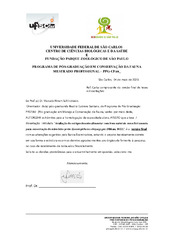| dc.contributor.author | Santana, Beatriz Cabrera | |
| dc.date.accessioned | 2020-05-16T19:31:02Z | |
| dc.date.available | 2020-05-16T19:31:02Z | |
| dc.date.issued | 2020-04-16 | |
| dc.identifier.citation | SANTANA, Beatriz Cabrera. Avaliação do enriquecimento alimentar com itens naturais como ferramenta para conservação do mico-leão-preto (Leontopithecus chrysopygus (Mikan, 1823)). 2020. Dissertação (Mestrado em Conservação da Fauna) – Universidade Federal de São Carlos, São Carlos, 2020. Disponível em: https://repositorio.ufscar.br/handle/ufscar/12731. | * |
| dc.identifier.uri | https://repositorio.ufscar.br/handle/ufscar/12731 | |
| dc.description.abstract | The black lion tamarin (Leontopithecus chrysopygus) is at the endangered of extinction and as a conservation strategy we have the ex situ management that aims to maintain a genetic and demographic bank of this species, seeking to reproduce these animals to reintroduce them into their natural environment when necessary and possible. Regarding foraging, the black lion tamarin consumes fruits, exudates, prey and flowers in the natural environment; capturing prey through manipulative foraging. However, the composition and the mode to provide their diet in captivity are different from what would be found in the natural habitat, and to don’t lost the foraging behavior it is necessary to make this aspect closer to the wildlife by food enrichment. Food enrichment decreases abnormal behaviors, stimulates new activities and the expression of the species' natural behavior that favors animal welfare. For this reason, the present study aimed to measure the influence of feeding enrichment on the foraging behavior of the black lion tamarin. To that end, 19 individuals were analyzed in two different environments and we made feeding enrichment by offering items from the natural diet of the species (jerivá fruits and tenebrio beetle) and from the captivity diet (fruits, vegetables and ration) in food enrichments, generating the total of 480 hours behavioral observation divided into 4 situations: without enrichment, with enrichment of the natural diet, with enrichment of the captive diet and with natural and captivity combined enrichment. Were observed 106 behaviors, grouped into 15 categories. In general, the enrichment with greater interaction was with captive items and as the important result it increased affiliation behavior compared to the situation of natural enrichment. Natural enrichment, on the other hand, increased feeding behaviors and decreased stopped behavior. The combination of enrichments with natural items and those of routine items decreased behaviors such as standing, locomotion and physiological categories. In addition, all situations had the interaction with enrichment and the ingestion of enrichment food increased significantly. Therefore, the results show that all the enrichments presented were important to stimulate natural behaviors and to improve the quality animals life, indicating a trend towards animal welfare. | eng |
| dc.description.sponsorship | Outra | por |
| dc.language.iso | por | por |
| dc.publisher | Universidade Federal de São Carlos | por |
| dc.rights | Attribution-NonCommercial-NoDerivs 3.0 Brazil | * |
| dc.rights.uri | http://creativecommons.org/licenses/by-nc-nd/3.0/br/ | * |
| dc.subject | Forrageio | por |
| dc.subject | Comportamento | por |
| dc.subject | Manejo ex situ | por |
| dc.subject | Bem-estar animal | por |
| dc.subject | Forraging | eng |
| dc.subject | Behavior | eng |
| dc.subject | Ex situ management | eng |
| dc.subject | Animal welfare | eng |
| dc.title | Avaliação do enriquecimento alimentar com itens naturais como ferramenta para conservação do mico-leão-preto (Leontopithecus chrysopygus (Mikan, 1823)) | por |
| dc.title.alternative | Evaluation of feeding enrichment with natural items as a tool for the black lion conservation (Leontopithecus chrysopygus (Mikan, 1823)) | eng |
| dc.type | Dissertação | por |
| dc.contributor.advisor1 | Schlindwein, Marcelo Nivert | |
| dc.contributor.advisor1Lattes | http://lattes.cnpq.br/9690898537150950 | por |
| dc.description.resumo | O mico-leão-preto (Leontopithecus chrysopygus) se encontra no status em perigo de extinção e como uma das ferramentas de conservação tem-se o manejo ex situ que visa manter um banco genético e demográfico dessa espécie, buscando reproduzir esses animais para quando necessário e possível reintroduzi-los em seu ambiente natural. Em relação ao forrageamento, o mico-leão-preto consome no ambiente natural frutos, exsudatos, presas e flores; capturando presas através do forrageamento manipulativo. Porém, no cativeiro a composição e o modo de oferta da sua dieta são diferentes do que seria encontrado no habitat natural, e para que o comportamento de forrageio não seja perdido é preciso tornar esse aspecto mais próximo do que seria encontrado pelos animais de vida livre através do enriquecimento alimentar. O enriquecimento alimentar diminui comportamentos anormais, estimula novas atividades e a expressão do comportamento natural da espécie que favorecem o bem-estar animal. Por isso, o presente estudo teve como objetivo central avaliar a influência do enriquecimento alimentar no comportamento de forrageio do mico-leão-preto. Para tal, foram analisados 19 indivíduos em dois ambientes diferentes e feito enriquecimento alimentar ofertando itens da dieta natural da espécie (frutos de jerivá e besouro de tenébrio) e da dieta de cativeiro (frutos, vegetais e ração) em enriquecimentos alimentares, gerando o total de 480 horas observação comportamental dividido em 4 situações: sem enriquecimento, com enriquecimento da dieta natural, com enriquecimento da dieta de cativeiro e com enriquecimento natural e de cativeiro combinado. Foram observados 106 comportamentos agrupados em 15 categorias. Em geral o enriquecimento com maior interação foi o com itens de cativeiro, tendo como resultado importante o aumento do comportamento afiliativo em comparação com a situação de enriquecimento natural. Já o enriquecimento natural, aumentou comportamentos de alimentação e diminuiu o comportamento parado. A combinação de enriquecimentos com itens naturais com os de itens da rotina diminuiu comportamentos como das categorias parado, locomoção e fisiológicos. Além disso, todas as situações tiveram a interação com enriquecimento e a ingestão de alimentos apresentados em enriquecimento aumentadas significativamente. Portanto, os resultados mostram que todos enriquecimentos apresentados foram importantes para estimular comportamentos naturais e melhorar a qualidade de vida dos animais, indicando uma tendência ao bem-estar animal. | por |
| dc.publisher.initials | UFSCar | por |
| dc.publisher.program | Programa de Pós-Graduação em Conservação da Fauna - PPGCFau | por |
| dc.subject.cnpq | CIENCIAS BIOLOGICAS::ZOOLOGIA::ZOOLOGIA APLICADA::CONSERVACAO DAS ESPECIES ANIMAIS | por |
| dc.subject.cnpq | CIENCIAS BIOLOGICAS::ZOOLOGIA::COMPORTAMENTO ANIMAL | por |
| dc.publisher.address | Câmpus São Carlos | por |
| dc.contributor.authorlattes | http://lattes.cnpq.br/6856379013323103 | por |


